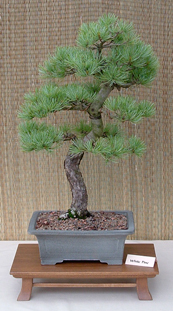Bonsai Tasks in January:
The holidays are now past and no longer occupy our days. All bonsai should be completely dormant by now and snug in their winter quarters. Keep checking for moisture and pests. Keep your bonsai and pots cleaned up to prevent mold and fungus.
The catalogs are coming in and thoughts of spring are beginning to stir in our minds. The weather is still too wintery to begin working on our trees so this is the month of planning. January is the month that we plan and prepare for the busy season of spring that will creep up on us before we know it.
Use this month to study your trees and plan the styling changes that you will effect this spring. Photographs and/or sketches, and notes will help remind you of what you had in mind, when the busy season arrives. Do not trust your plans to memory. I carry my memory around on a clipboard. On those trees that I plan to remove branches, I indicate those branches with a twist-tie. Other treatments to branches can be indicated by using different colors of twist-ties. Make sure that you keep notes on what each color twist-tie indicates. For ideas of styling on some of your trees, look at pictures in books and magazines. Somewhere there is a picture showing you just what you want to do with a particular tree. In your styling plans, do not forget the roots.
Your other planning tasks are repotting. Select the pots that you will use for your trees. Identify which pot goes with which tree. Again do not rely on memory. Include in those notes how and where the tree will be positioned in the pot. During my styling planning, I decide which is my front and indicate it in the pot using a wire staple or other marker. The more notes, indicators, sketches, photos, etc. that you produce during this planning month, the easier and faster your tasks will be when the spring rush begins.
Lastly, before that spring rush begins, you should have your potting soils ready. If you mix your own or modify purchased soil to your own formula, now is the month to do it. I mix some of my own and also purchase some. My standard mix is 1/3 aged pine bark, 1/3 turface, and 1/3 filter sand or chicken grit. I sift all ingredients before mixing to remove the fines.
I then modify this mix slightly for different species of plants, adding more sand or more bark depending on the needs of a particular tree. I also add mycorrhiza to all my mixes except those that I purchase from Hollow Creek Farms. It is already incorporated in their mixes.
Continue to keep a watch on the moisture in your pots. Keep an eye out for pests and fungus and keep your trees cleaned up.
That spring rush has a way of creeping up on us rather quickly. Get prepared!

